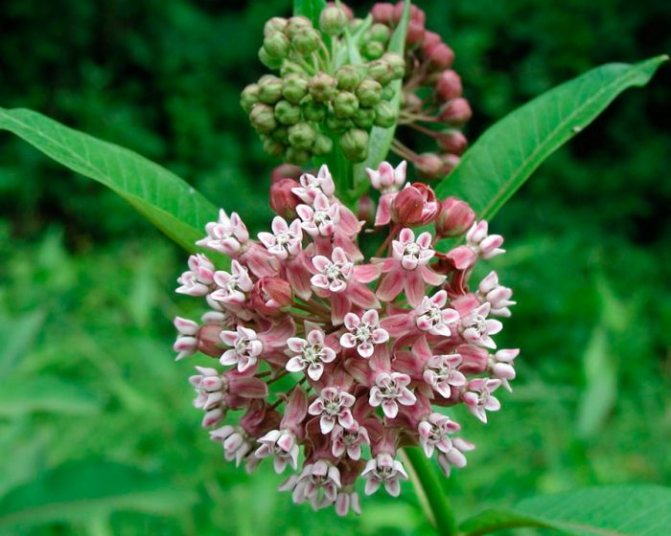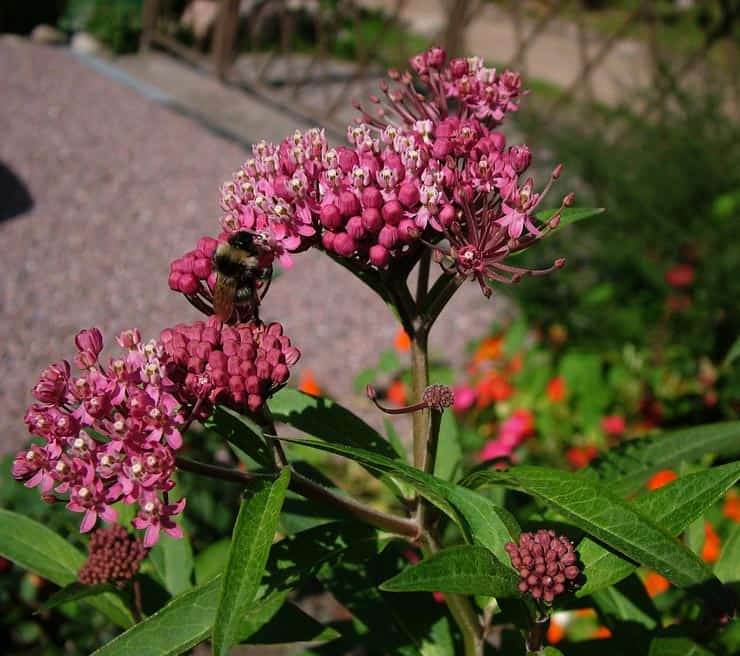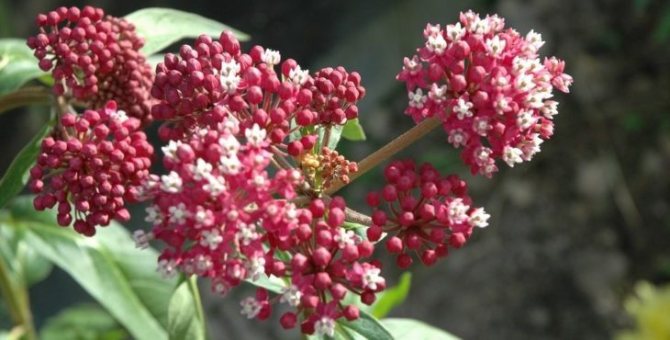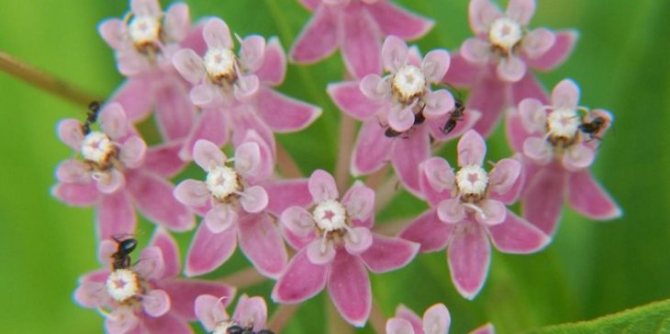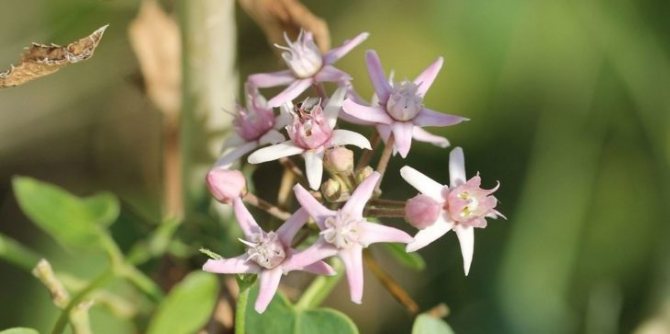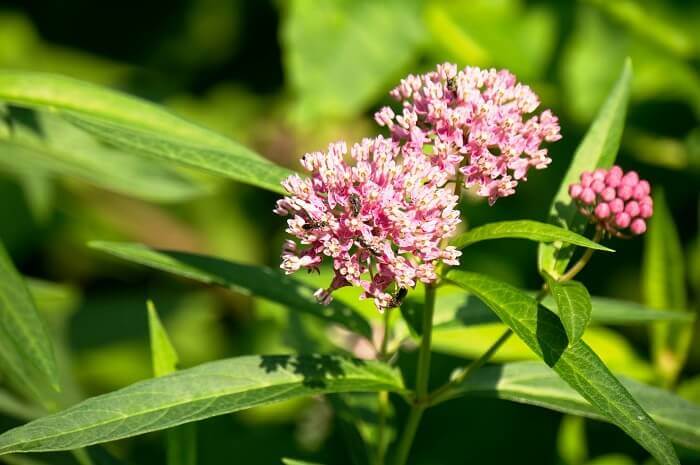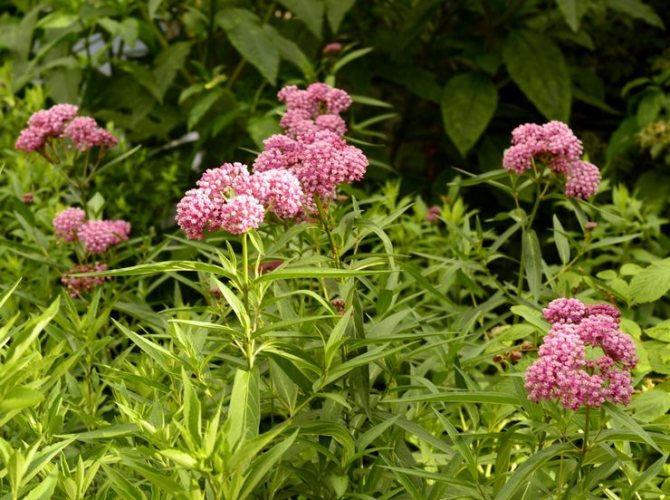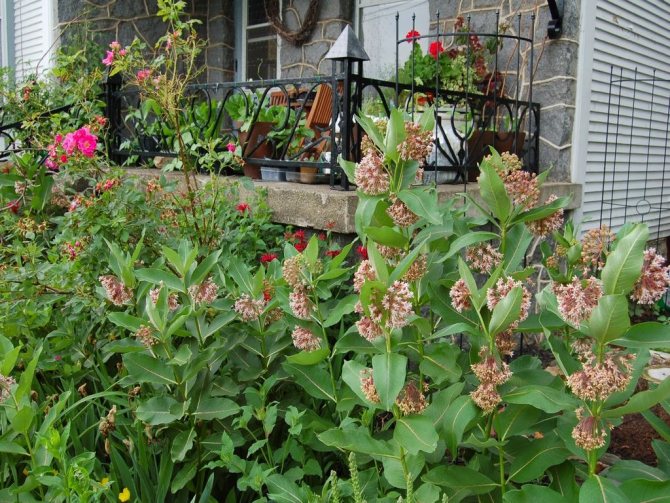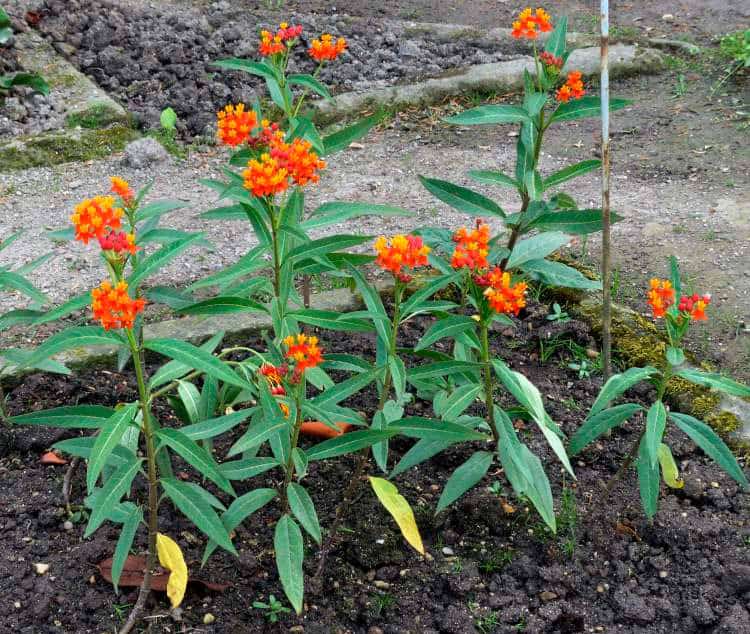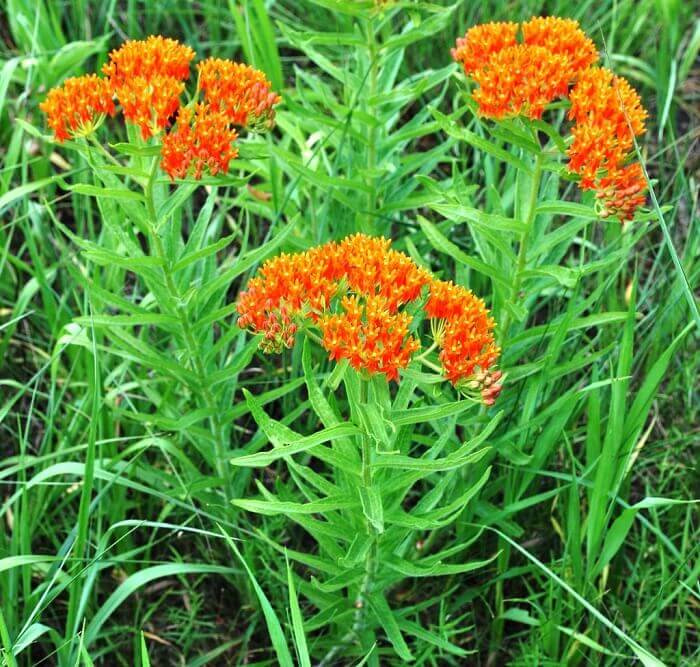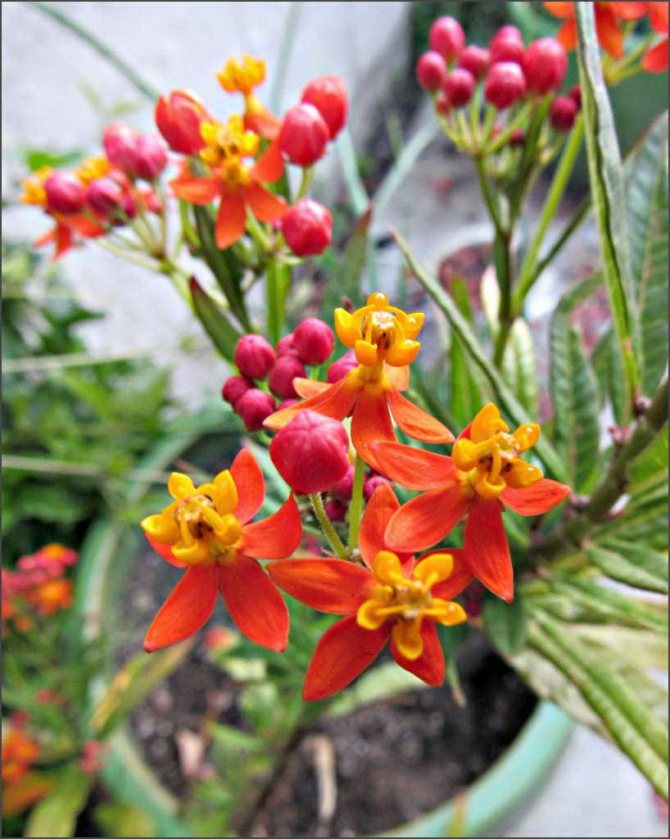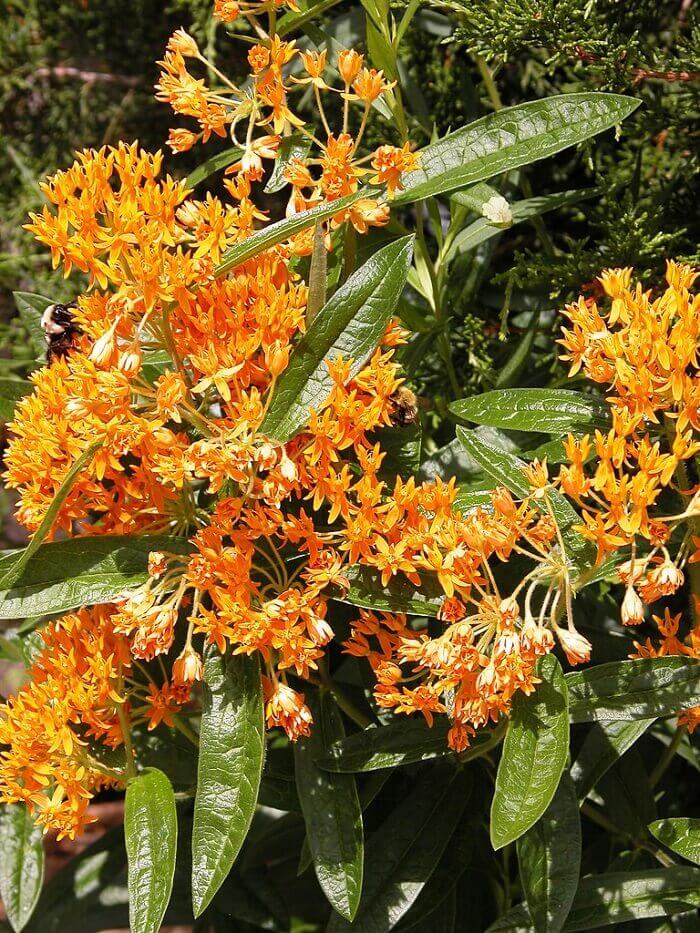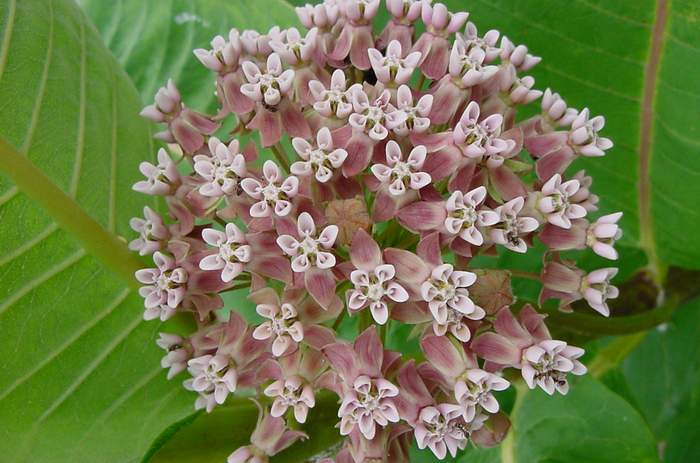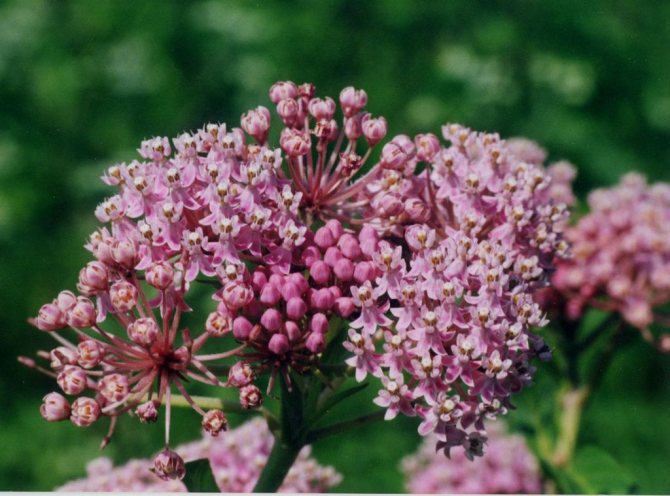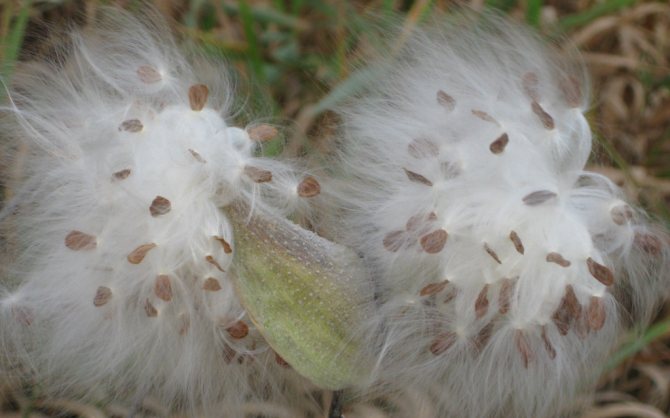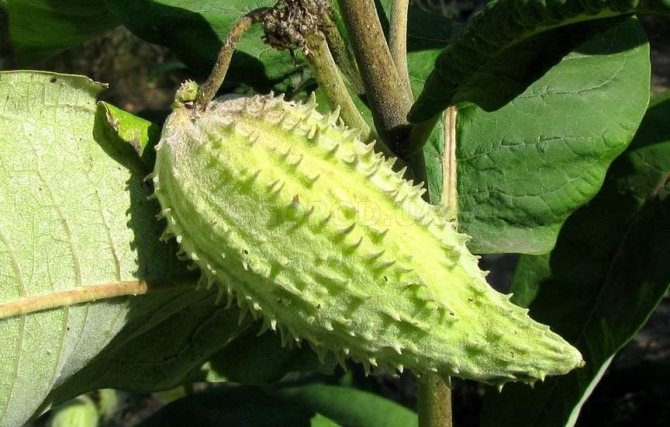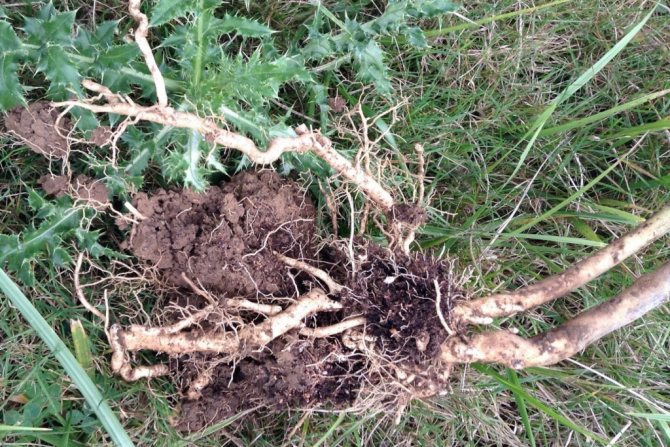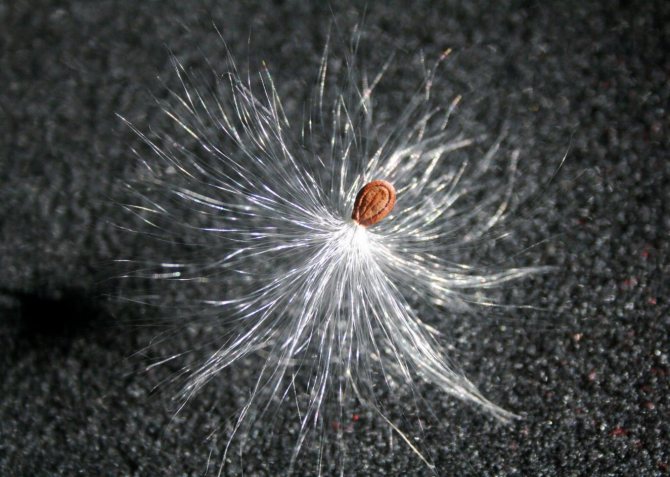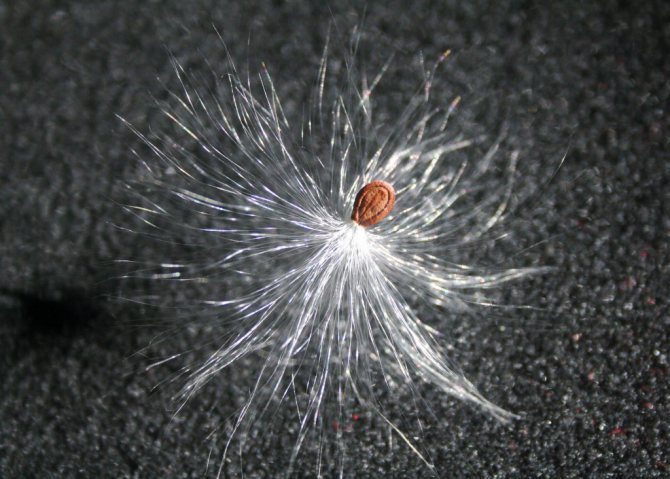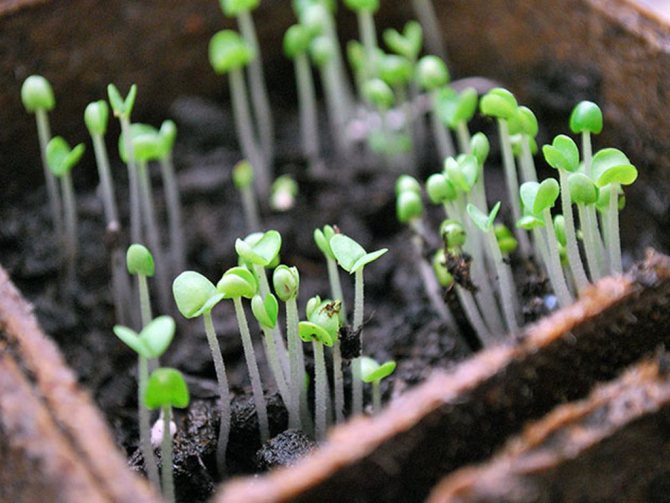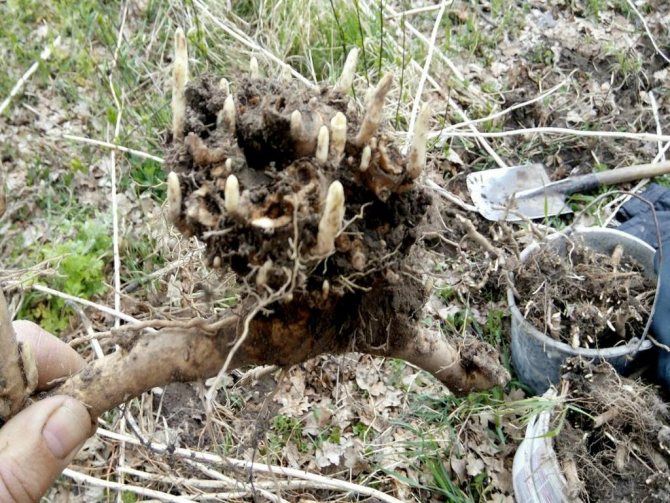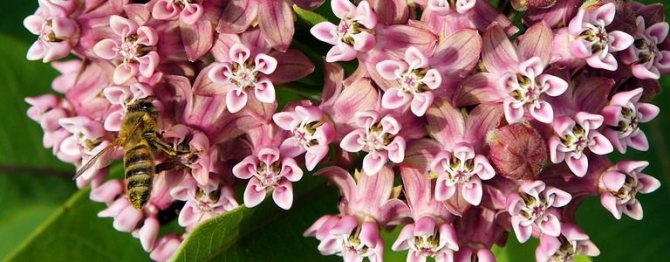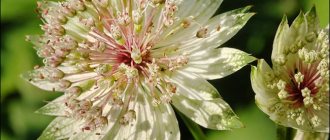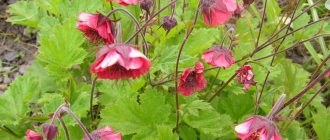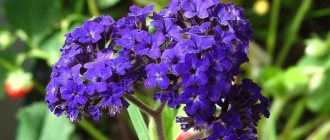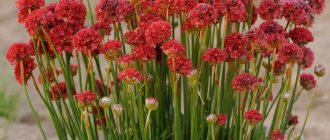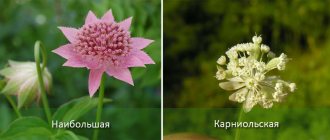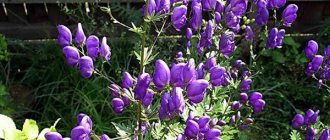Family: Kutrovye (Apocynaceae) Origin: North and South America Humidity: Moderate Location: Sunny and partial shade Soil: Any cultivated soil, fertile weakly acidic loams are desirable Pests and diseases: Spider mites Growth height: up to 70 cm Planting in the ground: May Flowering: July -August Suitable for cutting
Asklepias is another name for the cottonwood plant.
Features of the fleece
The height of the paddle can reach 100 cm. The thickened horizontal rhizome grows far enough to the sides. On thick shoots, whorled or opposite (less often alternately) are large leaf plates, the shape of which can be oblong, ovoid or elliptical. Large red or brown flowers are collected in multi-flowered umbellate inflorescences. Bushes bloom in summer or autumn. In faded bushes, fruits ripen, in which there is a large number of pubescent seeds, it is because of them that such a plant is called vatnik. This fluff is used in America for filling pillows. In mid-latitudes and in regions with a more severe climate, the seeds almost never have time to ripen. And in regions with a mild climate and warm winters, they have time to ripen and can crumble to the ground, giving abundant self-seeding.
All representatives of this genus have a poisonous milky juice. If it gets on the skin, it will cause redness and irritation, especially when exposed to direct sunlight. Such juice is used in folk medicine to remove warts. This culture is a melliferous plant, it attracts bees and butterflies to the garden, monarch butterflies like it especially.
Cotton wool, or Asklepias (lat.Asclepias) - a genus of the Kutrovye family, which includes more than 200 species of shrubs, dwarf shrubs and herbaceous perennials from South and North America. The genus includes both deciduous and evergreen species, and some of them have gained popularity as cultivated ornamental plants. The genus received its Latin name in honor of Aesculapius (Asclepius) for the medicinal properties of some of its representatives. The famous missionary, linguist, historian and explorer of Mexico, Bernardino de Sahagun, in his work "General History of New Spain" cited testimonies of the Aztecs that they used cotton wool to treat tumors arising from bone displacement.
Cotton wool came to Europe in the 18th century as a technical culture and spread very quickly: from the fibers of its stems, they made rope and stuffing for furniture and soft toys. Later, film and all kinds of life-saving equipment were made from it. With the advent of rubber, interest in cotton wool as a raw material was lost, but this plant can still be found in gardens and parks.
Transplantation of fleece and substrate
Like any other houseplant, it is better to replant asklepias only in spring, at the very beginning of the stage of active development. It is better to orientate for this perennial by the length of daylight hours: as soon as the sun warms up in the spring and the lighting improves, you can transplant the asklepias into a new container.
The plant does not need an annual transplant.Like any herbaceous perennial that has adapted to the conditions of a limited amount of soil, the potted willow is grown in one container as long as there is free soil. Only when the plant has completely mastered all the available soil space can it be transplanted into a new container. In years when there is no need to change the container, they simply replace the top layer of the substrate.
For indoor asclepias, it is advisable to select large, spacious containers. The diameter of the pot is increased by 4-5 cm compared to the previous container.
For Asklepias, the main characteristic of the soil is its nutritional value. The plant develops well in any universal loose soil mixture, both in purchased and independently mixed substrates. For a plant, you can make a simple mixture of equal parts of sod and leafy soil, adding half the parts of humus, sand and peat.
The wadders are not transplanted, but transferred without destroying the earthen coma and removing freely crumbling soil.
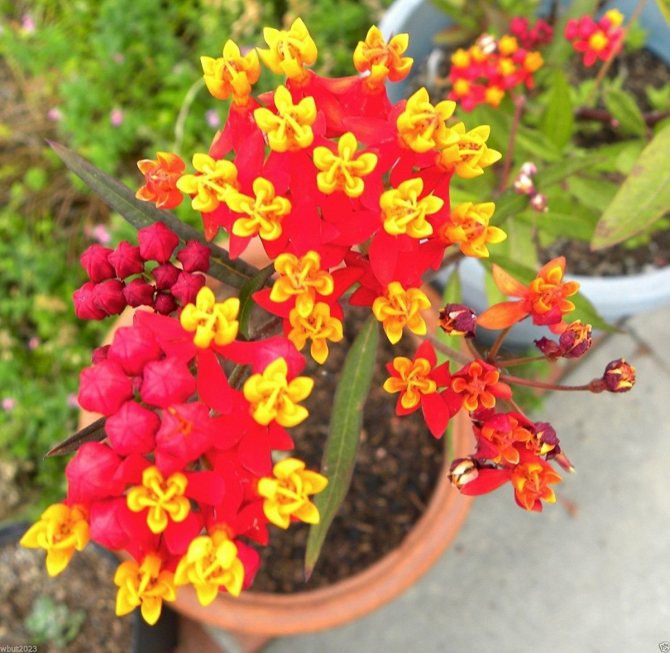
Kurasavsky vatnik in a pot
Planting and caring for cotton wool (in short)
- Landing: sowing seeds in open ground - in early spring, immediately after the snow melts, sowing seeds for seedlings - in late March or early April, planting seedlings in the garden - in early June.
- Bloom: summer or autumn.
- Lighting: bright light.
- The soil: fertile loam of slightly acidic reaction.
- Watering: in the evenings: after planting - frequent, and when the seedlings take root - only during drought.
- Top dressing: in poor soil: in spring - potassium sulfate, urea or compost, before flowering - a complete mineral complex, after flowering, Nitrofoska is added. When grown in fertile soil, top dressing is not needed.
- Reproduction: seeds, cuttings, dividing the rhizome.
- Diseases: stable.
- Pests: whiteflies and spider mites.
The use of asklepias (vatochnik) in landscape design
Asklepias combines well with various garden flowers, suitable for a garden in a natural style. You can plant it with various non-capricious perennials so that the garden does not require regular care. Good companions are monarda, aconite, bells, paniculata phlox, echinacea, knifofia, agapanthus, rudbeckia, liatris.
It is often planted along fences, its tall shoots enliven a boring fence, hiding everything that is not intended for the eyes of passers-by. It can be used to decorate septic tanks hatches or connect communication pipes. Dense shoots with kurpny leaves will completely cover the compost pit or cellar.
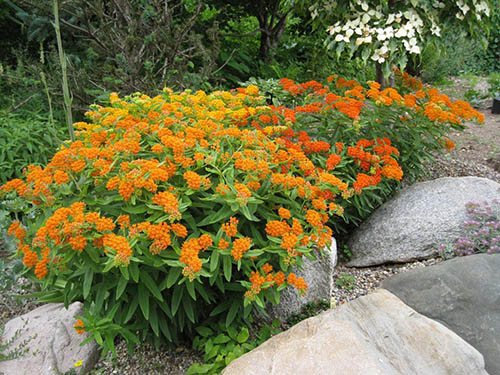

Without exaggeration, this is one of the best plants for planting in those parts of the garden where other types of flowers do not take root, as well as where regular maintenance is impossible.
Quilted flower - description
The asklepias plant can reach a height of 1 m.It has a horizontal, thickened, far spreading rhizome, thick stems with opposite or whorled, less often alternate large leaves that have an ovoid, oblong or elliptical shape, and multi-flowered umbrellas of large brown or red flowers ... The flowering of the fleece occurs in summer or autumn. After the completion of flowering, fruits ripen on the plant, filled with pubescent seeds, because of which the representatives of the genus are called vatniks.
In America, pillows are even stuffed with this fluff. In the middle lane and in places with a cooler climate, seeds rarely ripen, and in areas with warm winters, they not only have time to ripen, but also give abundant self-seeding. The milky sap of all plants of the genus is poisonous and causes irritation and redness of the skin, especially when exposed to sunlight. Asclepias juice is used, like celandine juice, to remove warts. The honey plant attracts not only bees, but also butterflies for pollination: it is especially liked by monarch butterflies.
Description of the plant Vatochnik
Vatochnik (Asclepias) genus from the Kutrovy family (Apocynaceae). It contains shrubs, semi-shrubs, perennial grasses and evergreen specimens. These are plants with opposite or alternate leaves, they are elliptical, ovoid, lanceolate. The inflorescences are umbrella-shaped, the color of the flowers is red, white, pink, orange and a rather pleasant aroma. Roots are strong and deeply embedded in the soil. The plant is a good honey plant.
There are white villi on the seeds of the fleece, hence its name. In culture, 1 species is used as an annual plant, as perennial 3 species. There are about 80 species in the genus. The juice of the milkweed is poisonous, so you should be careful.
Planting cotton wool in the open field
When to plant cotton wool in the ground
Growing vatnik from seeds in our climate is carried out both by seedling and non-seedling methods. The seed material of this plant remains viable for three years, but it is not possible to collect seeds every year: they require a very hot summer to ripen. However, you can purchase seeds from the store.
The seeds of the fleece should be sown for seedlings in late March or early April in a box with drainage holes and a loamy substrate. Seeds are covered to a depth of 10-15 mm, after which the crops are moistened from a spray bottle, covered with foil or glass and placed in a warm place. Every day, condensate is removed from the film, the crops are aired, and the substrate is sprayed from a spray bottle once every 2-3 days. Seedlings emerge together in 10-15 days, and then they are kept at a temperature not higher than 18 ºC, and when the seedlings get stronger, the cover is removed from the box.
There should be no problems with growing seedlings. At the stage of development in seedlings of two pairs of true leaves, they are dived into separate cups with a drainage layer 2-3 cm thick and a substrate of the same composition into which you sowed the seeds. The first two days after transplanting, seedlings require protection from sunlight. As soon as they take root, they are pinched. After two weeks of hardening, the seedlings of asklepias are planted in the flower garden at the beginning of June according to the scheme of 0.5x0.5 m.The first flowering of the vatnik from seeds occurs in the third or fourth year.
You can sow a fleece flower directly on a flower bed. Sowing seeds in the ground is carried out in early spring, immediately after the snow melts. The site is chosen well-lit, with cultivated soil. The optimum soil composition for asklepias is fertile, weakly acidic loam.
How to plant cotton wool
The site is pre-dug to the depth of the shovel bayonet, removing the roots of the weeds, after which the surface is leveled and furrows are made in it. The seeds of the fleece are sown to a depth of 3 cm and, after seeding, are watered abundantly. When sowing in dry soil, it is advisable to cover the beds with foil in order to accelerate the emergence of seedlings.
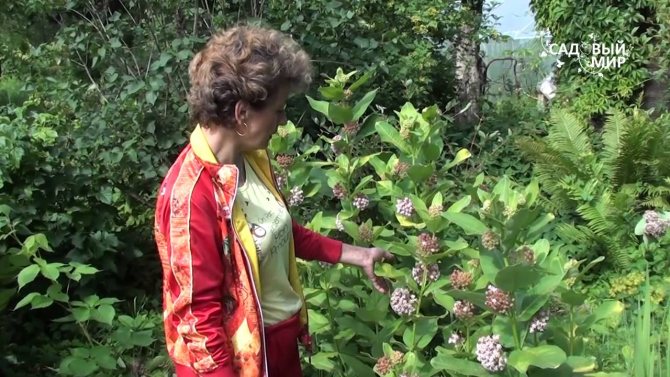

Some species of cottonwood require space constraints, since their shoots can sprout almost a meter from the mother plant. If you want to control the growth of the cotton wool, use a limiter or grow the plant in a container dug into the ground with drainage holes. In one place, with good care, asclepias can grow up to 15 years.
Growing cotton wool from seeds
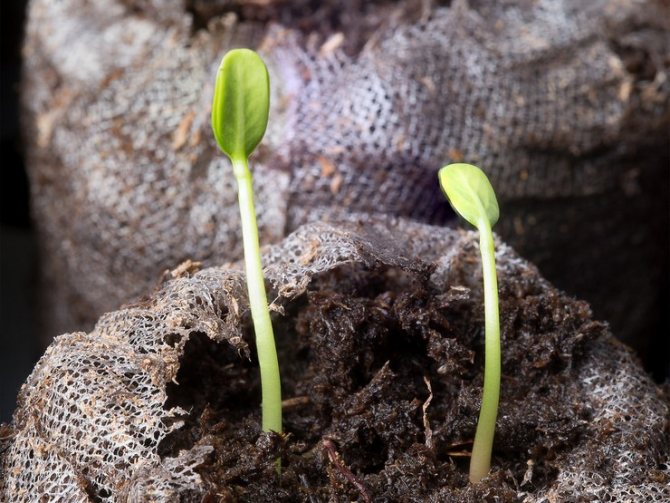

Sowing seeds
It is possible to grow vatnik, both with the help of seedlings, and in a seedless way. In order for the seeds on the plant to ripen well, certain conditions are required, which happen very rarely, so it is better to purchase cotton wool seeds in a special store for gardeners and gardeners.
The most suitable time for planting seeds for seedlings is the second half of March or the second half of April. It is best to choose loamy soil as the soil. The container for planting cotton wool seeds must have drainage holes. It is not necessary to deeply deepen the seeds during planting, 1 cm is enough.After planting cotton wool seeds, you need to thoroughly spray the soil with a puller and cover the container with plastic wrap or glass, this will help create a greenhouse effect.
Seedlings of fleece
You need to spray the seedlings every couple of days. It is necessary to remove the plastic wrap from the containers for ventilation every day, making sure to remove the accumulated condensation. The first shoots should appear in 10-14 days. The temperature for growing seedlings should be 18 degrees. After the seedlings become stronger, the plastic wrap or glass must be removed from the containers.
When the seedlings grow 2 true leaves, they must be transplanted into separate pots. Such pots must have a good drainage layer. The first few days after transplanting, the seedlings do not need to be placed in direct sunlight. When the seedlings move away from the transplant, it must be pinched. 2 weeks before the expected planting in open ground, it is necessary to start hardening the seedlings. It is necessary to take out the pots daily to fresh air. Start the hardening procedure from 10 minutes and gradually increase the time. Continue until the seedlings can be outdoors around the clock. Blossoming of a vatnik grown from seeds can be expected only after three to four years.
Caring for cotton wool in the garden
Growing cotton wool in the garden
Planting a fleece and caring for this plant in the open field comes down to the usual procedures for any gardener: watering, loosening the soil, weeding, fertilizing, forming and rejuvenating the bush, and if necessary, you will also have to process the fleece against diseases and pests.
Do not forget to remove wilted inflorescences, to prolong the flowering of the Asklepias, and to prune the stalks after flowering is complete, unless you plan on harvesting seed.
Watering and feeding the cotton wool
Immediately after planting, both the seeds and seedlings of the asklepias need frequent watering. Later, when the bushes get stronger, their powerful and branched root system will be able to independently provide them with moisture, but in dry season you still have to water the cottonwood in the evenings. For irrigation, use rain or sun-heated and settled tap water.
You don't need to pamper the plant with top dressing. Fertilizers in the form of potassium sulfate and urea, rotted manure or compost are applied to the poor soil in the area with cotton wool in the spring, as soon as young green growth appears. You can feed asklepias with a complex mineral fertilizer before flowering, and after its completion, add Nitrofoska to the soil. If you grow cotton wool in fertile soil, it will not need additional nutrition.
Vatochnik transplant
In one place, cotton wool can grow for more than 10 years. If there is a need to transplant a plant, then it is advisable to combine this procedure with dividing the bush in the spring or in the second half of summer. The fleece tolerates transplantation well, you just need to prepare a new site in advance and water the plant before digging out so that the earth remains on the roots. Planting asklepias and caring for him in a new place is carried out according to the scheme already described in the article.
Reproduction of cotton wool
Propagation of cotton wool by dividing the rhizome, as well as replanting the plant, is also better in spring or after the asclepias has faded. The bush is dug up, divided into parts, in each of which there should be a piece of rhizome with a kidney, then the cuttings are seated in pre-prepared pits. Parts of the fleece take root very easily, and they will be able to bloom in a year. At first, plots need intensive watering, and it will be possible to return to a moderate mode of soil moistening as soon as young plants have a strong root system.
The cottonwood is propagated by cuttings, which is carried out at the beginning of summer: young shoots are cut into 15 cm long segments, the lower leaves are removed from the segments, and the upper pair of leaf plates are shortened by half. The cuttings are placed in wet sand with the lower cut, after which the cuttings are covered with a transparent cap to create greenhouse conditions. Cuttings should be planted quickly so that they do not lose milky juice. Quilted cuttings are usually rooted within three weeks.
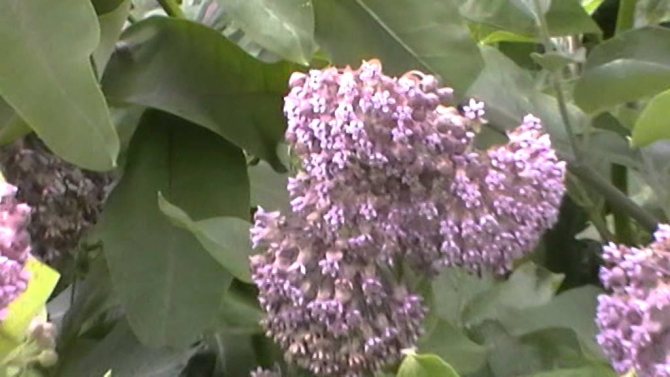

Cotton wool after flowering
With the onset of autumn, the fleece needs to be prepared for wintering, that is, to provide it with a shelter, for which dry fallen leaves, sawdust, crushed tree bark and other organic materials are useful. However, before mulching the site, you need to cut off the dry shoots of cotton wool at a height of 10 cm from the ground. They can also be used as mulch for the winter.
Reproduction of cotton wool
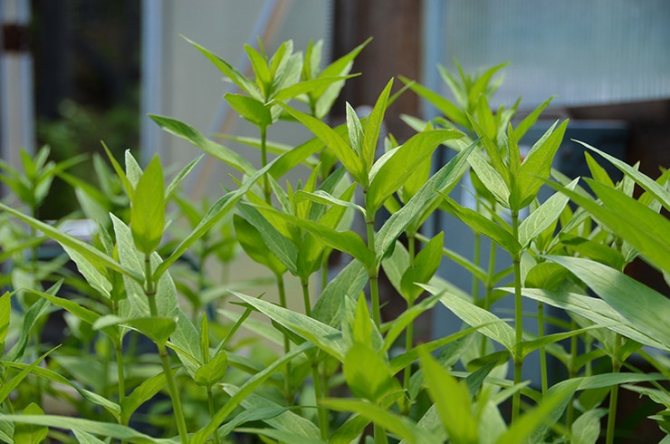

Vatochnik reproduce by dividing the bush best in spring or after flowering. The bush must be carefully dug up and divided into parts so that one delenka has at least 2-3 live buds. Then the resulting cuttings must be immediately planted in the prepared holes. It is very easy to accept a flower in a new place. Reproduction in this way makes it possible to get a plant that will bloom in a year. After transplanting the fleece, you need to water it abundantly. This watering should be continued until the plant has a good root system.
You can propagate a flower using cuttings. This procedure is carried out in early summer. From young shoots you need to cut the cuttings of 15 cm and remove the leaves from them. Then plant the cuttings in wet sand and cover with a cut plastic bottle to create a greenhouse effect. Planting must be done quickly so that the cuttings lose as little juice as possible. Rooting of cuttings occurs after about 3 weeks.
Pests and diseases of cotton wool
Asclepias is extremely resistant to pests and diseases. Of the harmful insects, whitefly can annoy the whitefly - a small insect resembling a moth and feeding on the cell sap of plants. The whitefly is destroyed with Actellik, Fufanon or Rovikurt, preparing an aqueous solution from them in accordance with the instructions and spraying the plant over the leaves with it.
Sometimes the plant experiences discomfort due to too dry air. To increase the humidity level in severe drought, you should spray the cotton wool with warm water in the evenings.
In dry season, spider mites can occupy the willow - also sucking pests from arachnids. It is difficult to see them on the plant due to their small size, but a sign of their presence - the thinnest cobweb - will help you determine the cause of wilting of leaves and deformation of the shoots of asclepias. Against spider mites apply treatments with acaricides: Aktellik, Aktara, Fitoverm and other drugs of similar action.
Use in site design
In the design of a summer cottage, swallow grass is used as a plant that disguises farm buildings, hedges, and garden equipment that are not distinguished by architectural sophistication.
The fleece looks spectacular as the central part of a small flower garden. It is planted in a large container without a bottom to limit the growth of roots, frame the planting with flowering annuals and perennials, cereals. But even without "accompaniment", he does not in the least lose its picturesqueness.
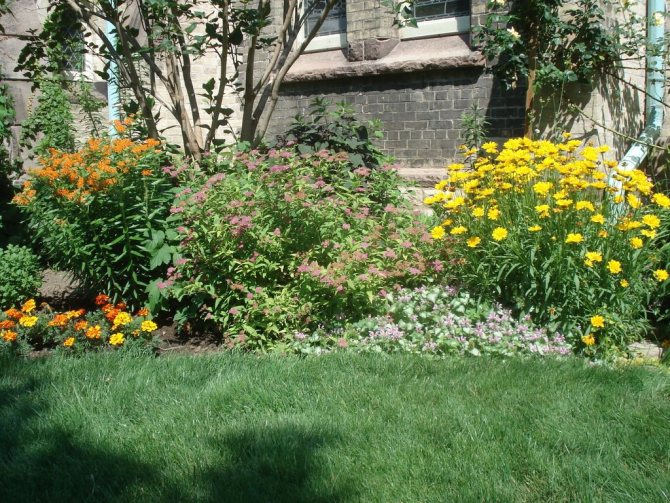

Cotton wool in garden design
Types and varieties of fleece
In perennial culture, three species of asklepias are grown and one willow is grown in gardens as an annual ornamental plant.
Incarnate vatnik (Asclepias incarnata)
Or red cotton wool, or cotton wool meat-red Is a perennial plant native to the central and eastern regions of North America with branchy leafy stems reaching a height of 120 cm.Elongated or broadly lanceolate, slightly pubescent leaves are located oppositely on the stems. Fragrant pink-purple or red flowers, collected in umbrellas up to 6 cm in diameter, open in July-August. Flowering lasts a little more than a month. This species has been cultivated since 1635. Best grade:
- Ice Belli - plant up to 1 m high with white flowers.
Tuberose cotton wool (Asclepias tuberosa)
Or asclepias tuberose, or tuberous wool reaches a height of 50 to 70 cm. This is an orange wadder: its large inflorescences of a bright yellow-red color adorn the plant from the middle of summer and almost all autumn. The plant is frost-resistant, although it needs shelter during severe frosts.
The most famous garden forms of asklepias tuberose:
- Gay butterfly - a mixture of varieties with red, yellow and orange flowers on plants up to 70 cm high;
- Vatochnik Maharaj - a bush about 50 cm high with bright orange inflorescences.
Syrian cotton wool (Asclepias syriaca)
Or aesculapian herb comes from the eastern states of North America, that is, the plant has nothing to do with Syria: the willow was named Syrian by mistake, since it was confused with the kendyr, which really grows in Syria. The mistake was sorted out, but the specific epithet "Syrian" was left for this type of asklepias. The perennial Syrian wadder reaches a height of one and a half meters. It has erect leafy stems and oblong-elliptical, leathery dark green leaves up to 15 cm long and up to 7 cm wide, reminiscent of the foliage of evergreen rhododendrons, which sometimes fall off in the lower part of the plant in mid-summer.
This is a pink vatnik: flowers up to 1 cm in diameter of a light pink shade, collected in umbrellas, bloom from July a little more than a month - about 35 days. The plant has been cultivated since 1629. Syrian cotton wool does not require shelter for the winter. The aroma of this species is peculiar: the plant smells like chocolate cake, and this smell is stronger than the aroma of meat-red wool.
Curassavian cotton wool (Asclepias curassavica)
Or gusset - a plant grown in an annual culture. With good care, this species reaches a height of one meter. Red or orange flowers attract many butterflies, but for many people, the pollen of this plant irritates the skin.
Description and appearance of the plant
Syrian vatochnik (asklepias, aesculapova, swallow or milky grass) is a representative of the kutrov family, which has nothing to do with Syria. He received the specific epithet as a result of external resemblance to the Middle Eastern kendyr.
The homeland of aesculapian herb is the American continent, where it was used as a technical crop. It was precisely as a raw material for the production of coarse fibers that asklepias was brought to Europe and Russia in the 17th century.
Syrian cottonwood is a herbaceous perennial with a powerful root system, reaching a height of 2 meters. Stems are straight, with large, up to 15 cm long and 7 cm wide, leaves. Powerful shoots are crowned with umbrella inflorescences, consisting of small, no more than one and a half centimeters in diameter, delicate pink flowers, enveloping the plant with the aroma of chocolate dessert.
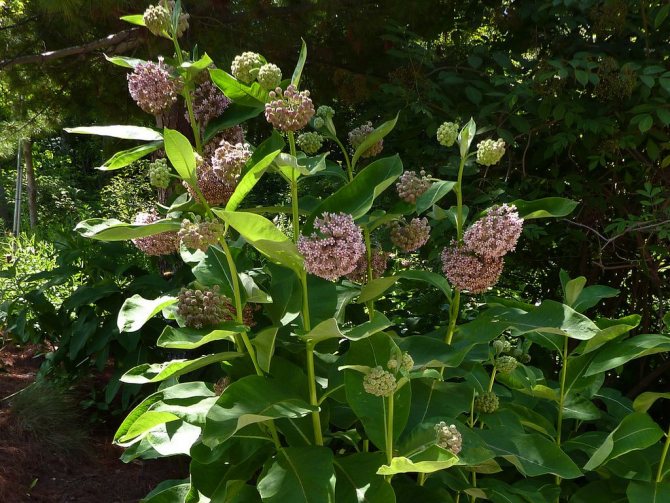

Syrian cotton wool bushes
The flowers themselves are arranged in such a way that any insect wishing to feast on nectar will not fly out without giving or collecting pollen. However, such a cunning device does not mean that the cotton wool belongs to self-pollinated crops.
In terms of flowering time, the plant is not classified as early, although in the south, with a warm, friendly spring, the first inflorescences open in the second half of June.
After flowering, lasting from July to August, the seeds are tied, which gave the Russian name to the plant. Each grain is surrounded by a feathery cloud, and until the wind disperses them, the inflorescence looks like a lump of silky cotton wool.
Interesting! It was planned to use the milky grass to obtain rubber, for which it was cultivated in special nurseries. However, the idea was not developed, since the production turned out to be economically unprofitable, and the quality of the final product was low.
Preparing cotton wool for winter
Winter hardiness in wadders is different, as mentioned above. If you need to cover them, then such insulation materials as dry leaves, spruce branches, agrofibre are used. Additionally, the soil is mulched using peat, compost.
In the spring, after the cover is removed, the perennial vatnik will give new growth, but the species grown by annuals (tuberous, kyurasavsky) simply will not survive the winter outdoors. Species highly dependent on heat can also be successfully grown at home, in a natural way (like perennial plants).
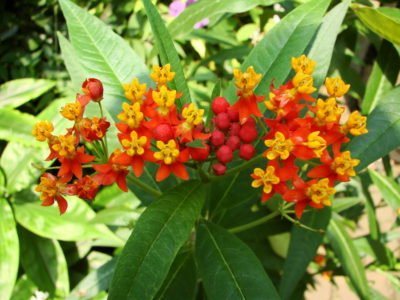

Choosing a landing site
Vatochnik is an unpretentious plant that grows in almost any soil, but slightly acidic loams are preferred for better development. The place where the cottonwood will grow should be sunny, without closely located groundwater.
In order for the fleece to be lush and beautiful, it needs to provide enough space for development; when planting, it is necessary to maintain a distance of at least 2 m to the nearest plant.
The Syrian species differs from others in aggressive soil colonization, so it is recommended to plant it in a pot with a thick drainage layer. The container with the cotton wool is dug into the ground, thereby limiting the growth of its processes.
Important! A bush growing in one place for more than 10 years needs a transplant for more favorable growth.
What plants is matted with
When planning the landscape on the site, it is necessary to take into account what kind of asklepias will be planted. After all, the varieties differ in height and volume of the bush. For example, a low tuberose vatnik, thanks to its orange inflorescences, goes well with lavender, sage, and some cereals.
If we talk about the varieties of the Syrian cotton wool, which has sufficiently high bushes, then it would be appropriate to plant yarrow, meadowsweet, catnip, and sloth next to it.
Vatochnik refers to those plants that not everyone decides to start on the site. First of all, gardeners are afraid of its overgrowth. However, with proper care and timely limitation of the spread of the rhizome, the plant is capable of pleasing for more than one year with interesting inflorescences and an unusually pleasant aroma.
Transfer
Despite the long lifespan of perennial varieties, a rejuvenating transplant is recommended at intervals of 4-5 years, unlike many other centenarians. This allows not only to extend its life and flowering, but also gives it a more presentable, neat look. The new place should not have cardinal differences from the old one in terms of soil, illumination or moisture content of the substrate, because the transplant itself is stress for the plant. But in general, the culture tolerates it well.
Medicinal properties of the plant and application in homeopathy
Vatochnik has a long history of use as a medicinal plant. Due to the presence of cardiac glycosides, similar to strophanthin, it helps with heart and vascular failure, drugs based on it are also effective for shortness of breath, arrhythmias, tachycardia. The plant also has an expectorant, antispasmodic, antimicrobial effect. For medicinal purposes, inflorescences, roots, seeds and milky juice are used, from which tinctures, decoctions, powders are made.
Thanks to amino acids, quilted plant extract helps to fight various skin diseases. This and other plant-based forms in phytocosmetics are used as a rejuvenating agent.
Caution! Vatochnik contains glucoside asclepiadin, which has a powerful laxative effect.An overdose of drugs based on it is fraught with serious poisoning and can be fatal.
You can get acquainted with the features of growing cotton wool in the proposed video. Happy viewing!
Possible growing problems
Vatochnik is resistant to various diseases and pests, in rare cases, a small fly can climb its bush - whitefly, which feeds on its juice, which can lead to drying out. You can get rid of the pest with the preparations "Fufanon" "Rovikurt" or "Actellik", prepared according to the instructions.
Another problem that a fleece may have when planting and caring for is improper air humidity. With excess moisture, the plant will be affected by mold, and with insufficient moisture, the leaves will turn yellow and begin to fall off.
In the first case, it is necessary to reduce the level of humidity, if it is a seedling or a plant in a pot, then the container with the cotton wool must be rearranged to a drier place, in the second, periodic spraying will help.
Did you know? The fluffy fibers that cover the asclepias seeds repel moisture: this “cotton wool” used to be used in the manufacture of life jackets.
general description
Another name for vatnik is gusset. Belongs to the Kutrov or Lastovnev family. The plant is powerful, bushy and tall enough for a herbaceous perennial, reaching a meter or more in height. Large leaves sitting in pairs have an oval or longitudinal shape. The rhizome is strong, thickened, grows horizontally and can extend long distances from the central bush. Inflorescences are complex-umbellate, fragrant, attracting bees, are excellent honey plants. Painted in brown-red or dirty pink color, less often greenish-purple with long pointed leaves. Flowering occurs in the second half of summer and early autumn.
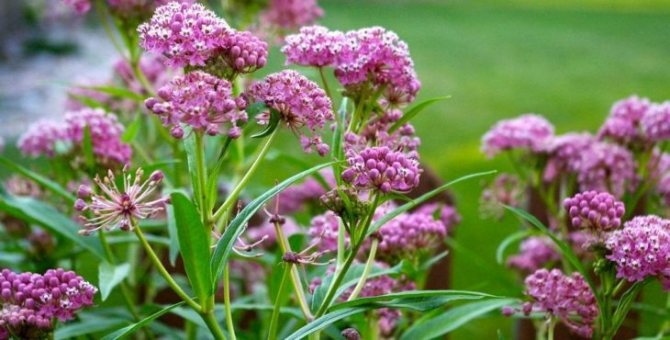

The plant got its name for the characteristic tuft of seeds, which are similar to cotton wool. They were often used by the people in this capacity. Seed capsules are large, up to 10 cm, self-expanding. After opening, the pubescent seeds are carried by the wind over long distances, however, in the conditions of middle latitudes, self-sowing culture practically does not spread due to the cold autumn.
The cotton wool has medicinal and technical uses. In addition to replacing cotton wool in domestic conditions, it, along with other threads, was used for the production of yarn and fabrics. There were attempts to obtain rubber from the milky sap of the plant, but the idea was unsuccessful.
Botanical portrait
Syrian cotton wool (Asclepias syriaca) L. from the Asclepiadaceae family is a perennial herbaceous rhizome plant with a height of 0.7 to 1.8 m.The core root penetrates to a depth of 3-4 m and has a system of horizontal roots that branch off from the main one is almost at right angles and are located in the soil in tiers in an amount from 3 to 5. The first is at a depth of 8-10 cm, the second is 16-18 cm, the rest are deeper. A large number of buds are formed on the core part and lateral branches, from which upright stems develop.
Leaves are entire, oblong-elliptical in shape, short-pointed, rounded, with a thick midrib, whitish below from dense tomentose pubescence, covered with scattered hairs above, short-petiolate.
The flowers are collected in dichasia with strongly shortened internodes and form a cymose inflorescence - a false umbrella. Each flower sits on a peduncle attached to a flower-bearing stem, the length of which is 4-8 cm. Both pedicels and flower-bearing stems are densely pubescent. Inflorescences are located in internodes, mainly in the upper part of the stem. The flowers are large, white to purple in color. Although I personally came across only plants with dirty pink flowers.
The fruit is a polyspermous elliptical leaflet 6-10 cm long and 1.5-2.5 cm wide, slightly extended towards both ends, whitish from dense, short and soft pubescence. Seeds are flattened, ovate, with a wide wrinkled edge and with elongated, keeled, darker tubercles on both sides.
Care features
- It is often necessary to water the plant only when it is planted. Then the root system itself provides moisture in the right amount. Although in the hot season in the evening you can water the cottonwood, make sure that the soil does not dry out.
- In the spring, after the germination of the first green shoots, mineral fertilizers are applied to the soil to nourish the plant after winter.


It is advisable to periodically form a bush and do sanitary pruning. It is also necessary to remove inflorescences that have faded. To rejuvenate the bush, sometimes all branches are cut to the root. Later, new ones appear from it.
Interesting facts about cotton wool
1. "Vata" Asklepias has a persistent water-repellent effect. Therefore, in the past, Vatochnik's fluff was stuffed into life jackets.
2. Asklepias grows very quickly, while its tall stems do not need support. Thanks to this, you will be able to enjoy the aroma of its buds every flowering period of Vatochnik, if you plant seedlings right under your window.
3. The Asklepias will become welcome residents of mixed flower beds. Butterflies will flock to the sweet aroma of its tall buds, creating a picturesque natural picture right on your garden plot.
Video about the honey plant Syrian cottonweed:
Essential oil, rubber and more ...
This plant, as, indeed, most of the genus wadder, is widespread in North America. It got to Europe in the late 17th - early 18th centuries. It spread rather quickly in England, Germany, France and Finland. At the beginning, cotton wool was introduced to Europe as a technical culture. The stems were used to produce fibers for coarse fabrics, ropes, stuffing for upholstered furniture and toys.
Syrian willow (Asclepias syriaca) is one of the most cold-resistant and drought-resistant species of the genus Asclepias. It was grown mainly as a pleasantly smelling, but, in general, it is not clear what a useful plant is. Indeed, its flowers, collected in globular inflorescences, have a delightful aroma of hyacinth. In the Nikitsky Botanical Garden in the 30-50s, it was studied as an essential oil plant. Of the 26 studied species of the genus Asclepias L. (this is how the genus is called “medically” in Latin), it turned out to be the most promising. The yield of flower raw materials was 40-50 c / ha, however, at a very low, only 0.05-0.1%, the content of essential oil. But it is obtained by extraction, which makes it possible to obtain a substance containing not only volatile substances, the so-called concrete.
The essential oil was obtained from the inflorescences. Therefore, the fleece belongs to the group of floral raw materials. On the fourth day, from the opening of the first buds, more than 90% of the flowers bloom in the inflorescence. It is at this moment that the content of the concrete is maximal, and its perfumery assessment is the highest.
In all parts of the flower, the content of concrete ranges from 0.34 to 0.54% of the raw mass of raw materials; pedicels, cups, corollas also have a different smell. For example, corollas and inflorescences have a strong heliotropic odor, the calyx has a slightly heliotropic odor, and the pedicels have a resinous-terpineol shade.
The concrete of the Syrian willow from the inflorescences is a yellow-gray solid with a very pleasant resinous-hyacinth smell with a note of heliotrope. The inflorescences are extracted with petroleum ether for 30 minutes. followed by washing. After distillation, a hardening concrete is obtained.
In the 30s, this plant was studied in detail for various purposes - it was proposed to use the fluff from leaflets with seeds to warm the clothes of polar explorers (the Arctic was then in vogue) instead of eider down. Indeed, it practically does not get wet and holds the volume well. Something like a modern padding polyester.
Vatochnik was used as an anti-erosion plant, since its horizontally diverging rhizomes and roots are arranged in several tiers and fix large volumes of soil. Recommended for landscaping.
Another direction of its then study was the production of rubber. All parts of the plant secrete milky juice, and the USSR in the 30s was in great need of rubber. And as its source, they studied the Central Asian dandelions kok-sagyz and tau-sagyz, and, at the same time, cotton wool. He still has more mass.
The whole plant contains triterpene saponins, which have an irritating effect, flavonoid glycosides, lignans, milky juice contains the poisonous glucoside asclepiadin, seeds - a brown dye, up to 20% fatty oil, which was tried to be used in the textile industry, to obtain solid fats, to make protective coatings.
Vatochnik is an excellent melliferous plant, the productivity of one hectare is 600 kg of honey, which has a strong aroma and is not sugar-coated during storage.
And now only the decorative function remains.
Trimming the fleece
Pruning, despite the fact that the wadder does not like it, must be performed, of course, if a perennial species is grown.
Sanitary pruning is sometimes carried out towards winter, cutting off the aerial parts of the plants, but it is recommended to leave the shoots with leaves for this period, postponing the cutting of old shoots in the spring.
When flowering comes, it depends on the type chosen - it is either autumn or spring. After wilting, the flowers are cut off immediately, which prevents self-seeding. Eradicating a fleece growing next to another plant in a flower bed is not an easy task.


Useful properties and contraindications
Syrian cotton wool is not only a highly decorative melliferous garden plant. All parts of it - from roots to seeds - have medicinal properties that were used by the Indians of North America. Modern pharmacology uses the plant as part of medicines for the treatment of diseases of the heart and blood vessels, respiratory organs, and skin problems. Medicinal decoctions are useful for diabetes, hypertension, act as a mild laxative and diuretic, and are important for men's health.
Usually they use dried raw materials, which are harvested after the seeds have ripened, less often fresh leaf juice for the treatment of warts, lichens.
Attention! Before using medicines made from aesculapian herb, you should consult your doctor.
Internal use of decoctions and infusions is contraindicated in hypotension, bradycardia.
Exceeding the dosage of preparations based on vatnik can lead to a significant deterioration in the condition, up to a lethal outcome.
Landing rules
Asklepias is an unpretentious ornamental plant, but still there are some features in its cultivation.


- It grows on any soil, but loamy and slightly acidic is preferred. It is recommended to choose an open and sunny, well-ventilated place for planting. Damp and swampy areas with groundwater close to the topsoil are undesirable.
- it is better not to plant anything within a radius of two meters, because the cotton wool grows strongly, especially the Syrian one. The latter is sometimes planted in a pot in open ground in order to limit the growth of root shoots. For him, a drainage layer is important and obligatory in the pot.
- All cereals will be bad neighbors for a handsome wadder. But he gets along very well with decorative ones. Bells, echinacea, meadowsweet and asklepias will complement each other perfectly.
Before planting the plant, it is necessary to dig up the ground well, free it from weeds and loosen it. Some growers add compost to the soil for fertilization. The most important thing is to take into account the strong growth of the flower and choose a place that is spacious enough so that it does not overwhelm other flowers and feel comfortable.
Varieties and varieties with photos
Vatochnik, asklepias or lastovin - all these are the names of one plant that is part of the Lastovnev family. Eight dozen varieties belong to it.In ornamental gardening in our conditions, only four of them are common.
Asklepias kurassavsky
Kurassavsky willow (A. Curassavica) - in natural conditions, a perennial, evergreen dwarf shrub, up to a meter in height. Due to the fact that he loves warmth, in our climate it is grown as an annual or at home. The leaves of this plant are intensely green from above, and from below, due to slight pubescence, seem almost gray. Seeds sprout in a couple of months after sowing, and in a couple of months this vatnik blooms with bright orange flowers with a yellow center. Together they form ten-centimeter umbrellas that adorn the tops of the stems. In a mild climate, they bloom for almost six months.
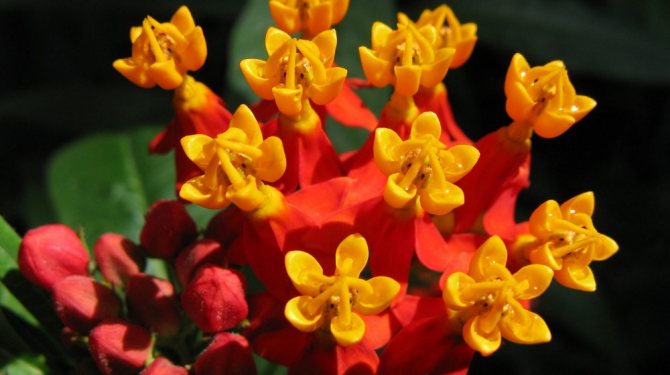

Kurassavsky cotton wool
Syrian honey wool
Syrian cottonwood (A. syriaca L.) is a one and a half meter long, perennial shrub with powerful pubescent stems and large ovoid leaves. A very hardy plant that hibernates without shelter. This species is named Syrian by mistake, it has nothing to do with this country and was imported from America.
The Syrian is growing rapidly, occupying large territories. It blooms for about a month in July with umbrellas of pink, white or red-green color. They give off a strong aroma reminiscent of fruit or candy. The plant is valued as a wonderful honey plant.
From a hectare of Syrian cotton wool plantings, up to 600 kg of high-quality, light honey is obtained.
Once in the fields, the Syrian wadder behaves aggressively, oppressing the crops, complicating the harvest. Even weeds do not grow next to it, farmers attribute it to malicious weeds. With the dominance of this crop, almost a third of oats, about 20% of soybeans, etc. are lost in the fields.
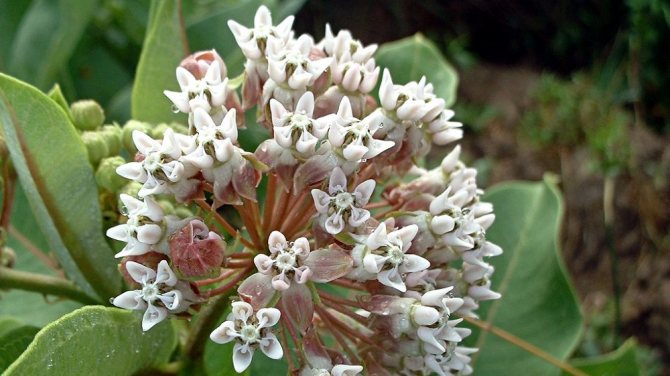

Syrian cotton wool
Tuberous fleece
Tuberous or tuberose willow (A. tuberosa) is a thermophilic plant that blooms profusely in greenhouse conditions from July almost to the end of autumn. In the open field, flowering is not so long. Bright orange flowers, collected in umbrellas, with a pleasant smell are attractive to insects. There are varieties with yellow and red fragrant flowers.
The growth of tuberose willow does not exceed 70 cm, the bush grows rapidly, it has dense shoots with pubescent leaves. He loves the sun and moisture, in the middle lane he does not tolerate wintering well, needing to be transplanted into a greenhouse or in a solid shelter.
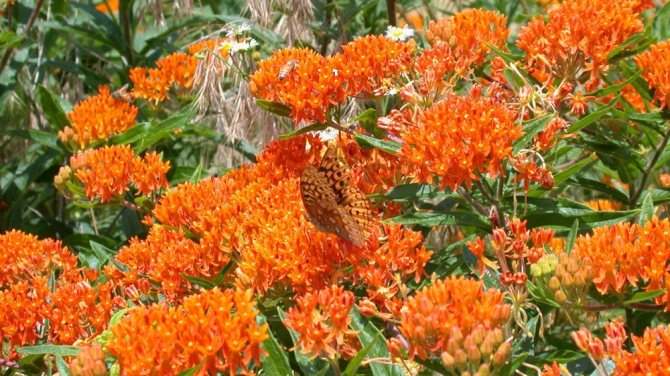

Tuberous cotton wool
Vatochnik incarnate
Incarnate or meat-red vatnik (A. incarnata) also belongs to perennial dwarf shrubs. Its meter-long bush has a regular shape with a branched stem and elongated, hairy leaves. It blooms in July for about a month with purple-pink, red, sometimes white flowers. Six-centimeter umbrella-shaped inflorescences exude a delicate chocolate aroma. The plant loves the sun, but is not afraid of light shading. During the wintering period, it needs mulching and shelter.
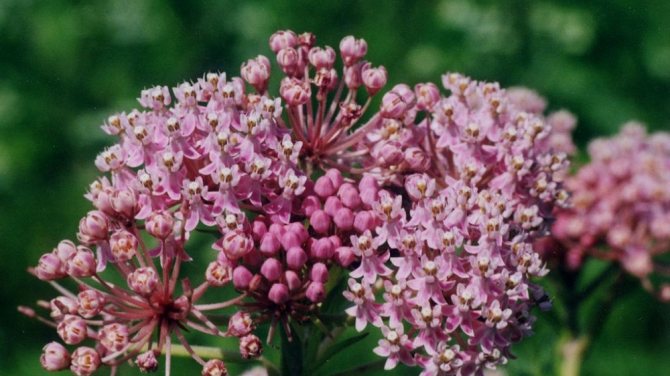

Vatochnik incarnate
Since ancient times, cotton wool has been used to make ropes, essential oils, cotton wool and medicines. The rubber produced from it turned out to be unprofitable due to its poor quality. An attempt to produce a silky fabric was unsuccessful due to its fragility, and materials for padding furniture and pillows, produced for a long time, have now replaced synthetic winterizer and foam rubber.
Wintering
Not all types of asklepias tolerate winter cold well. The only "Siberian" among the varieties of culture is the Syrian vatnik. It can be left to winter as it is. Others require varying degrees of cover, for which fallen leaves, sawdust and other materials are well suited as a thick layer of mulch. Before sheltering, it is necessary to cut off all the shoots of the current year up to 10 cm from the ground. They are also left in the garden for insulation.
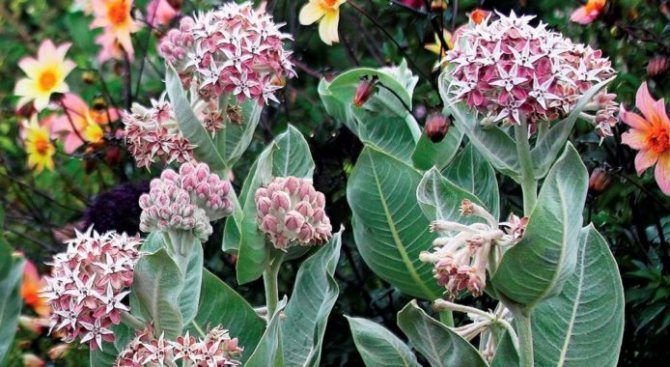

Content
- Description
- Planting cotton wool When to plant
- How to plant
- Growing
- Incarnate cotton wool (red, meat-red)
Harvesting of seeds, flowers, roots
All parts of the plant, including milky sap, begin to be harvested in June. Harvesting of roots is carried out a little earlier, in April, after the appearance of young shoots. They dig it out, clean it from the ground, the aboveground part, cut it into thin rings, and dry it. Seeds, fruits are harvested as they ripen in several stages, dried with a dryer, in a ventilated room or attic. The highest quality raw materials are obtained after drying in a natural way. Store in paper or cloth bags. The inflorescences are suitable for making folk remedies throughout the year, the herb retains the beneficial properties of the vatnik for two years, the roots are three.
Types of asklepias
In addition to the Syrian, other species are cultivated in their summer cottages:
Incarnate or meat red... Up to 120 cm high. Flowers are usually red, purple-pink.
Tuberose or tuberous... Undersized - up to 70 cm. Inflorescences of a rich fiery orange hue blaze in flower beds until the end of autumn. Requires shelter for the winter.
Curasavsky (lastoven)... Orange, in the latitudes of Russia is grown as an annual. The height of the flower is about a meter, the color is orange-red. Pollen often causes allergic skin reactions.
Good varieties that are most popular with gardeners:
- “Ballet on ice”, one meter high, with white flowers;
- "Cinerella", 80–100 cm, pink in color;
- "Maharaja", 60 cm, fiery orange, adapted for indoor growing;
- "Soul mate", interesting with pale pink petals of the upper tier of flowers and rich lilac lower ones;
- "Boa", also with two-colored, white-purple flowers, which gives the inflorescence a delicate, airy look.
Having planted cotton wool in a summer cottage, the gardener will not only receive an exquisite plant that fits into the landscape in an interesting way, but also a wide range of home first-aid kit.
>



